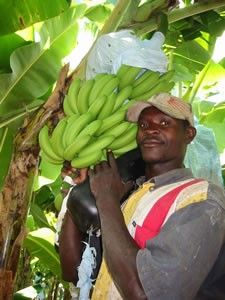Monitoring Report Reveals Key Insights into Impact of Fairtrade

As sales of Fairtrade products continue to grow around the world, the need for understanding the impact increases. Fairtrade International (FLO) has released ‘Monitoring the Scope and Benefits of Fairtrade 2012’, a compendium of data and summaries of key research exploring the impacts of Fairtrade.
“Fairtrade is making a difference for over a million farmers and workers and their families, as this report shows,” says Harriet Lamb, Chief Executive at Fairtrade International. “The rich data here gives insights into our core strengths – for example our world class work with smallholder organisations – as well as those areas where we need to improve, such as in furthering workers’ empowerment and progress toward a living wage.”
The report highlights the importance of small farmer organizations in the Fairtrade system. By the end of 2011, the total number of small-scale farmers in the Fairtrade system reached 1.24 million with a 26 percent increase in sales revenues on Fairtrade terms.
* The overall number of producer organizations increased 10 percent, and the total number of farmers and workers in the system increased 13 percent between 2010 and 2011.
* Smallholder organizations reported a 30 percent increase in sales revenues on Fairtrade terms, and a 26 percent increase Fairtrade Premium in the time period under review.
* Strong growth in cocoa and sugar between 2010 and 2011. Fairtrade Premium received by smallholder cocoa farmers increased 89 percent; total farmers producing Fairtrade sugar grew from 17,600 to 37,200. This reflects the initial results of large scale commitments to Fairtrade by major sugar and chocolate companies.
* Challenges in the worker sector. While the data show strong growth across many indicators for small producer organizations, plantations and other hired labour set-ups in some product areas continued to sell only a relatively small share of their production as Fairtrade. Recognising this, Fairtrade International is beginning implementation of a new Hired Labour Strategy to increase impact and ensure greater benefits for workers.
From sugar farmers in Guyana to banana workers in Ghana, information from 990 out of 991 producer organizations make this report the most complete ever. The report contains over 100 charts and graphs showing where Fairtrade farmers and workers are located (top country isKenyawith 173,800 farmers and workers), and information about production and sales, and how producers use the Fairtrade Premium (strong preference among small farmer organizations to invest in business development).
In addition, this year’s report includes summaries of recent in-depth research into the impacts of Fairtrade in specific products and countries, as well as including some individual producer stories. This allows readers to look beyond the data on sales, production, and Fairtrade Premium to gain insights into areas that are of key importance to Fairtrade, such as worker empowerment and producer organization strengthening.


































